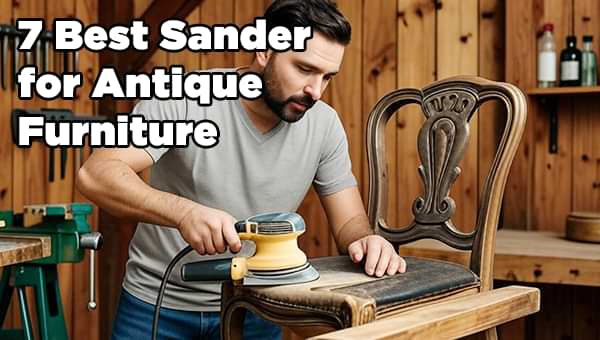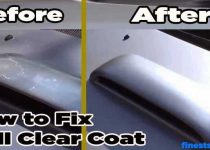7 Best Sander for Antique Furniture 2025 [Restore & Refinishing]
Restoring antique furniture is a labor of love. It’s an art form, truly. You’re bringing old pieces back. These items hold stories. They need gentle handling. Choosing the right sander is vital. It’s the difference between success and damage. Don’t rush this decision.

Antique furniture restoration isn’t just sanding. It’s about respecting the past. You want to enhance, not harm. A good sander helps achieve this. It smooths surfaces. It preps for new finishes and preserves the wood’s character. This helps your restoration journey.
Top Product Recommendations:
- SKIL 5” Random Orbital Sander (SR211601): Excellent dust collection. Variable speed.
- DEWALT Random Orbit Sander (DWE6423): Powerful motor. Comfortable grip.
- SKIL Corded Multi-Function Detail Sander (SR232301): Versatile attachments. Reaches tight spots.
Table of Contents:=>
- Key Features to Look for in an Antique Furniture Sander:
- Buying Guide: Choosing The Best Sanders for Old & Antique Furniture –
- Reviews: The 7 Best Sander for Antique Furniture of 2025 –
- #1. SKIL 5” Random Orbital Sander with Cyclonic Dust Box & 3pc Sanding Sheet –
- #2. DEWALT Random Orbit Sander, Variable Speed, 5-Inch (DWE6423) –
- #3. SKIL Corded Multi-Function Detail Sander with Micro-Filter Dust Box –
- #4. DEWALT 20V MAX Orbital Sander Cordless, 5-Inch Sander Tool –
- #5. BLACK+DECKER Detail Sander, 1.2 Amp, 16,000 OPM, Corded (BDEMS600) –
- #6. WEN 6307 Variable Speed Detailing File Sander with 1/2-by-18″ Belt –
- #7. 5-Inch Random Orbital Sander, HYCHIKA 13000RPM Electric Orbital Sander for Woodworking –
- Maintenance Tips for Your Sander –
- Why Sanding is Essential for Antique Furniture:
- Types of Sanders for Furniture Restoration –
- The Sandpaper Grits for Antiques –
- Why Trust These Reviews and Products?
- Final Verdict:
Key Features to Look for in an Antique Furniture Sander:
When buying, consider features. They impact performance and affect ease of use. Make an informed decision.
a) Variable Speed Control:
This feature is crucial. It lets you adjust speed. Slower speeds for delicate work. Faster for quicker removal. It prevents overheating. It protects antique wood.
You’ll change speeds often. Different woods react differently. Different grits require adjustments. Variable speed is non-negotiable.
b) Dust Collection System:
Sanding creates dust. A good system is essential. It keeps your air clean and improves visibility. It protects your lungs. Look for cyclonic systems.
Dust bags are common. Vacuum attachments are better. Connect to a shop vac. This is the most effective. It minimizes airborne particles.
c) Ergonomics and Comfort:
You’ll use it for hours. Comfort is important. Look for a good grip. It reduces fatigue. It improves control. Rubberized grips are ideal.
Weight also matters. Lighter sanders are easier. Heavy ones cause strain. Test different models if possible. Find what feels right.
d) Pad Size and Shape:
Most orbital sanders are 5-inch. Some are 6-inch. 5-inch is versatile. It’s a good all-around size. Detail sanders have triangular pads.
Consider the furniture size. Large pieces might use 6-inch. Small intricate parts need detail sanders. Match pad to task.
e) Power Source: Corded vs. Cordless:
Corded sanders offer constant power. No battery worries. They’re usually more powerful. They’re good for long sessions.
Cordless offers portability. No tangled cords. Great for quick jobs. Batteries run out, though. Have spares ready.
Buying Guide: Choosing The Best Sanders for Old & Antique Furniture –
Selecting the right sander involves careful thought. Consider your specific needs. Think about the projects you tackle.
a) Project Scope:
Are you restoring a single piece? Or many items? For extensive work, invest more. For a small project, a basic model is fine.
b) Type of Furniture:
Delicate, carved pieces demand detail sanders. Flat, large surfaces are for orbitals. Understand the furniture’s complexity.
c) Budget Considerations:
Sanders range widely in price. Set a budget beforehand. You don’t need the most expensive. Look for value and features.
d) Corded vs. Cordless Needs:
Corded offers consistent power. Cordless offers freedom. If power outlets are limited, go cordless. If you work in a fixed shop, corded is great.
e) Brand Reputation and Warranty:
Established brands often mean quality. They offer better support. Check warranty details. It protects your investment.
f) Accessories and Attachments:
Some sanders come with extras. Attachments increase versatility. Sandpaper assortments are helpful. Consider what’s included.
Reviews: The 7 Best Sander for Antique Furniture of 2025 –
Let’s dive into specific models. We’ll examine each closely. You’ll see their strengths and weaknesses.
#1. SKIL 5” Random Orbital Sander with Cyclonic Dust Box & 3pc Sanding Sheet –
This SKIL sander is a popular choice. It’s known for its effective dust collection. The cyclonic dust box works well. It’s a reliable orbital sander.
Specifications:
- 5-inch pad.
- 120V corded.
- Variable speed dial.
- Cyclonic dust box.
Features:
The cyclonic dust separation is excellent. It collects fine particles. This keeps the air cleaner. It also extends filter life. The variable speed dial offers control. It adapts to different tasks. The ergonomic design feels good. It reduces hand fatigue.
Pros:
- Superior dust collection.
- Variable speed for versatility.
- Comfortable to hold.
- Good value for money.
Cons:
- Cord length could be longer.
- Dust box needs frequent emptying.
Why Use This Product:
It’s ideal for general sanding tasks. The dust collection is a major plus. You’ll appreciate the clean workspace. It handles tabletops well. It’s perfect for dressers.
User Test Experience:
“I used this on an old oak dresser. The dust collection was amazing. My workshop stayed much cleaner. It removed the old finish smoothly. The variable speed helped with delicate areas. I’m very impressed with its performance.”
#2. DEWALT Random Orbit Sander, Variable Speed, 5-Inch (DWE6423) –
DEWALT is a trusted brand. This orbital sander is robust. It’s built for serious work. It delivers consistent power.
Specifications:
- 5-inch hook-and-loop pad.
- 3.0 Amp motor.
- Variable speed (8,000-12,000 OPM).
- Dust-sealed switch.
Features: The powerful motor handles tough jobs. The variable speed dial is intuitive. It changes speeds easily. The dust-sealed switch protects it. This extends tool life. The rubber overmold grip is comfortable. It provides good control.
Pros:
- Powerful and durable.
- Excellent variable speed control.
- Comfortable grip.
- Effective dust collection port.
Cons:
- Dust bag can get full quickly.
- It’s a bit heavier than some.
Why Use This Product:
If you need a workhorse, this is it. It’s great for sustained sanding. It removes old finishes efficiently. It’s perfect for large antique pieces.
User Test Experience:
“I inherited an old dining table. This DEWALT sander made restoration easier. It smoothed out years of neglect. The variable speed let me be gentle. I connected it to my shop vac. Dust was minimal.”
#3. SKIL Corded Multi-Function Detail Sander with Micro-Filter Dust Box –
This SKIL detail sander is versatile. It comes with multiple attachments. It’s designed for intricate work. It’s perfect for fine details.
Specifications:
- 1.2 Amp motor.
- Corded operation.
- Micro-filter dust box.
- Includes three attachments.
Features: The interchangeable attachments are key. They allow sanding in tight spots. The pointed pad reaches corners. The finger attachment gets into grooves. The profile attachment conforms to shapes. The micro-filter dust box works well. It captures fine dust.
Pros:
- Highly versatile with attachments.
- Excellent for intricate details.
- Good dust collection for its size.
- Compact and easy to handle.
Cons:
- Less aggressive for large areas.
- Sanding sheets can be specific.
Why Use This Product:
For carved furniture, it’s indispensable. It handles spindles beautifully. It gets into tight crevices. This sander saves a lot of hand sanding.
User Test Experience:
“I was restoring an antique chair. It had intricate carvings. This detail sander was a lifesaver. The finger attachment worked perfectly. It got into every curve. The finish was incredibly smooth.”
#4. DEWALT 20V MAX Orbital Sander Cordless, 5-Inch Sander Tool –
This DEWALT offers cordless convenience. It provides freedom of movement. It’s a powerful battery-operated option. The kit includes everything.
Specifications:
- 5-inch pad.
- 20V MAX battery.
- Variable speed (8,000-12,000 OPM).
- Included battery and charger.
Features: Cordless operation is a huge plus. You’re not tied to an outlet. The variable speed dial is standard. It offers precise control. The dust bag works adequately. It’s part of the DEWALT 20V system. This means battery compatibility.
Pros:
- Unrestricted movement.
- Strong motor for cordless.
- Variable speed control.
- Part of a larger battery system.
Cons:
- Battery life can vary.
- Can be heavier with the battery.
Why Use This Product:
For portability, it’s unbeatable. If you work in different spots, it’s great. It’s perfect for quick touch-ups. No need to find an outlet.
User Test Experience:
“I was working on an armoire. It was too big to move easily. This cordless sander was perfect. I moved around it freely. The power was surprising for a battery tool. I kept an extra battery charged.”
#5. BLACK+DECKER Detail Sander, 1.2 Amp, 16,000 OPM, Corded (BDEMS600) –
This BLACK+DECKER detail sander is compact. It’s designed for accessibility. The 3-position grip offers comfort. It’s an affordable option.
Specifications:
- 1.2 Amp motor.
- 16,000 OPM.
- Corded.
- Includes dust collector.
Features: The compact design is great. It fits into tight spaces. The 3-position grip improves comfort. It allows different hand placements. The dust collector bag works. It helps keep the area tidy.
Pros:
- Very compact and lightweight.
- Good for small, intricate areas.
- Comfortable grip options.
- Budget-friendly price.
Cons:
- No variable speed control.
- Dust collection could be better.
Why Use This Product:
For light-duty detail work, it’s suitable. It’s good for beginners and ideal for small decorative pieces. It’s a solid entry-level choice.
User Test Experience:
“I needed something for a small jewelry box. This sander was perfect. It was easy to hold. It reached all the tiny corners with too powerful, which was good.”
#6. WEN 6307 Variable Speed Detailing File Sander with 1/2-by-18″ Belt –
This WEN tool is a file sander. It uses a narrow belt. It’s designed for shaping and detail. It gets into very tight spots.
Specifications:
- 0.8 Amp motor.
- Variable speed.
- 1/2-by-18 inch belt.
Features: The narrow belt is its main advantage. It fits where other sanders can’t. The variable speed is useful. It provides precise control. It’s good for shaping wood. It’s also for removing material.
Pros:
- Reaches extremely tight areas.
- Good for shaping and carving.
- Variable speed control.
- Lightweight and maneuverable.
Cons:
- Can be aggressive if not careful.
- Belts wear out quickly.
Why Use This Product:
For intricate carvings, it’s invaluable. It’s perfect for shaping curves. It removes material selectively. Use it with extreme caution.
User Test Experience:
“I had some damaged table legs. This file sander reshaped them. I was able to match the original curves. It’s a specialized tool. It does that one job perfectly.”
#7. 5-Inch Random Orbital Sander, HYCHIKA 13000RPM Electric Orbital Sander for Woodworking –
The HYCHIKA orbital sander is a budget-friendly option. It offers variable speed. It’s a good entry point. It’s suitable for general tasks.
Specifications:
- 5-inch pad.
- 13,000 RPM max.
- 6 variable speeds.
- Includes sandpaper and dust bag.
Features: The 6-speed settings give flexibility. You can adjust for different woods. It comes with sandpaper. This is convenient for beginners. The dust bag is included. It helps manage debris.
Pros:
- Affordable price point.
- Good variable speed range.
- Comes with accessories.
- Lightweight and easy to use.
Cons:
- Dust collection is average.
- Not as powerful as premium models.
Why Use This Product:
If you’re on a budget, it’s a solid choice. It performs well for general sanding. It’s great for hobbyists. It’s good for occasional use.
User Test Experience:
“I needed a sander for a small cabinet. This HYCHIKA worked fine. It was easy to operate. The different speeds were helpful. It’s a good value for the money.”
Maintenance Tips for Your Sander –
Proper maintenance extends tool life. It ensures consistent performance. Don’t neglect your sander.
- Clean Dust Box/Bag: Empty after each use. Clogged filters reduce efficiency.
- Inspect Sanding Pad: Look for wear and tear. Replace if it’s damaged.
- Check Power Cord: Ensure no frays or cuts. Safety is paramount.
- Clean Vents: Dust can clog motor vents. Use compressed air. This prevents overheating.
- Store Properly: Keep it in a dry place. Protect it from dust. A case is ideal.
Why Sanding is Essential for Antique Furniture:
Sanding prepares surfaces perfectly. It removes old finishes. It smooths imperfections. This creates a clean slate. New finishes adhere better. You’ll get a beautiful result.
However, be careful. Over-sanding can destroy value. It removes patina. Patina adds character. It shows age gracefully. You don’t want to erase it. Use the right grit. Apply light pressure.
Sanding also reveals damage. You might find hidden cracks. You might see loose joints. Address these before finishing. It’s part of the process.
Types of Sanders for Furniture Restoration –
Different sanders suit different tasks. You need to know their uses. Each excels in specific areas. Let’s break them down.
A) Random Orbital Sanders:
These are popular choices. They combine two motions. They rotate and orbit. This prevents swirl marks. You get a very smooth finish. They’re versatile tools.
They’re great for large, flat areas. Tabletops are a good example. Cabinet doors also benefit. Their dust collection is often good. This keeps your workspace clean.
However, they can be aggressive. You need a light touch. Start with finer grits. Don’t press too hard. Let the tool do the work.
B) Detail Sanders:
Detail sanders are compact. They have a triangular pad. They reach tight spaces. Corners and crevices are no problem. They’re perfect for intricate work.
Think carved legs. Consider decorative trim. These are where detail sanders shine. They’re less powerful than orbitals. They remove less material. This is good for delicate areas.
They often have attachments. These further enhance versatility. Finger attachments are common. Profile attachments help with curves.
C) Belt Sanders:
Belt sanders are powerful. They remove material quickly. They’re for heavy stock removal. They’re usually not for antiques. They can be too aggressive.
They’re great for rough lumber. They shape wood fast. But for delicate pieces? Avoid them. They’ll remove too much material. They’ll damage the patina.
If you must use one, be cautious. Use a very fine grit. Apply almost no pressure. This is generally not recommended.
D) Palm Sanders (Finish Sanders):
Palm sanders are rectangular. They use quarter sheets. That is vibrate in small circles. They produce fine finishes and good for final passes.
They’re less aggressive than orbitals. They’re also less powerful for light sanding. That is smooth out surfaces. They prep for stain or paint.
However, they can leave swirl marks. You must sand with the grain. This minimizes visible scratches. Always follow wood direction.
E) Orbital Sanders (Conventional):
These are different from random orbitals. They only move in circles. They’re generally older designs. They often leave swirl marks. They’re not ideal for fine finishes.
Random orbitals replaced them. They’re rarely recommended now. For antique furniture, avoid them. They’ll likely cause damage. They won’t give a smooth look.
The Sandpaper Grits for Antiques –
Sandpaper grit is very important. It determines abrasion. Use the right grit sequence. Start coarse, finish fine.
- Coarse (60-80 grit): Rarely for antiques. Only for heavy stripping. Be extremely careful.
- Medium (100-120 grit): For removing old finish. For initial smoothing. Use with caution.
- Fine (150-180 grit): For general sanding. After medium grit. Preps for staining.
- Very Fine (220-320 grit): For final smoothing. Before sealing or painting. Ensures silkiness.
- Extra Fine (360+ grit): For between coats. For super smooth finishes. Not always necessary.
Always test on an inconspicuous area. See how the wood reacts. Never skip grits. This creates deep scratches. They’re hard to remove later.
Why Trust These Reviews and Products?
We base our recommendations on several factors and consider product specifications. We focus at user reviews and also rely on expert opinions.
Our goal is to provide honest assessments. I focus on real-world application. We want you to make the best choice.
We understand antique furniture and know the care it requires. I chose sanders suitable for this task. You can trust our selections.
Final Verdict:
Choosing the best sander for antique furniture depends. It depends on your specific needs. The SKIL SR211601 is an excellent all-rounder. Its dust collection is impressive. The DEWALT DWE6423 offers power and reliability. For intricate work, the SKIL SR232301 detail sander is a must-have.
Consider having more than one sander. An orbital for large areas. A detail sander for precision. This gives you maximum flexibility. Always prioritize variable speed. Always use appropriate grits. Most importantly, be patient. Enjoy the restoration process!
Last Updated on October 20, 2025 by Rogers Weber
[As an Amazon Associate I earn from qualifying purchases.]


